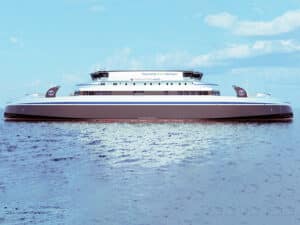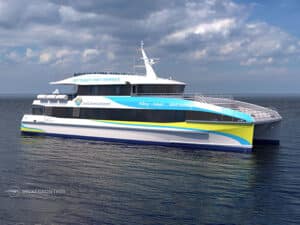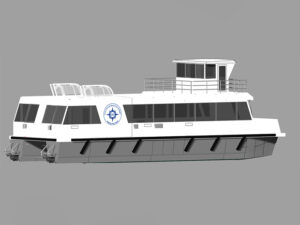
A Q&A with ferry attorneys Katherine M. Tsou and Steven D. Miller of Hanson Bridgett
Written by Marine Log Staff
Katherine M. Tsou and Steven D. Miller
Tell us about your practice at Hanson Bridgett.
Hanson Bridgett is California’s premier law firm for public transit providers and holds a unique status as legal counsel for most of the Bay Area’s public transit agencies and transportation authorities. As general counsel to both the San Francisco Bay Area Water Emergency Transportation Authority (San Francisco Bay Ferry) and the Golden Gate Bridge, Highway and Transportation District (Golden Gate Ferry), we assist with a wide range of issues related to ferry operations and public agency governance. We help our clients comply with local, state, and federal rules that arise in an array of scenarios, including procurements, contract negotiation and management, reallocation of resources, labor negotiations, and complex litigation. We enjoy finding ways to implement our clients’ goals and objectives on a sound legal basis and in a cost-effective manner.
What do you like most about your job?
One of the best parts of our job is the people we work with. We are lucky to work with smart and creative people who are enthusiastic about public service and public transit. Ferry operators are entrepreneurial and dynamic, often presenting us with novel projects and solutions to problems, which makes our job fun.
Another great part of our job is the variety of issues that come across our desks. For example, on an average day we might review a contract for specialized engine equipment, update a Board policy, advise on federal requirements applicable to a solicitation, assist with a Title VI matter involving equity in the provision of ferry service, and draft the terms and conditions for a contest to boost passenger engagement. We enjoy learning new things and helping our clients navigate a wide range of legal issues in real time. There is never a dull moment.
How have your ferry clients adapted to changes in ridership since the COVID-19 pandemic?
Despite decreased ridership due to the pandemic, both San Francisco Bay Ferry and Golden Gate Ferry seized new opportunities to enhance their ferry service.
In 2021, San Francisco Bay Ferry revamped its service by reducing fares by up to 30% and increasing weekday service by 30%. They added a direct commute service between Oakland and Downtown San Francisco and opened the new Alameda Seaplane Lagoon ferry terminal. As a result, San Francisco Bay Ferry is outpacing comparable regional transit operators in ridership recovery. San Francisco Bay Ferry has also leaned into off-peak and special event service to build a more resilient revenue base given uncertainty around return-to-office policies.
When a private ferry operator announced that it would no longer run ferry service between the San Francisco Ferry Terminal and Angel Island State Park (an island in the middle of San Francisco Bay), Golden Gate Ferry stepped up to ensure ferry access to this popular destination. Beginning in December 2021, Golden Gate Ferry started operating a new service seven days a week to and from San Francisco Ferry Terminal and Angel Island State Park. They have successfully brought thousands of Bay Area residents and visitors from all over the world to Angel Island to enjoy the island’s rich history, hiking trails, camping sites, beaches, and stunning views.
Golden Gate Ferry also continues to adjust service in response to demand. In September 2022, Golden Gate Ferry added three trips to its afternoon/evening service between Larkspur and San Francisco.
What are some of the cutting edge legal issues facing your ferry clients?
Ferry operators in San Francisco are leaders in decarbonizing ferry service. Both Golden Gate Ferry and San Francisco Bay Ferry are preparing to transition to zero-emission ferries and to build shoreside infrastructure to support a clean ferry network. This state-of-the-art program will present a host of interesting legal issues related to procurement, environmental review, operations, and intergovernmental coordination.
Both San Francisco Bay Ferry and Golden Gate Ferry have implemented Disadvantaged Business Enterprise (DBE) programs designed to promote DBE and small business participation. Due to the specialized facilities, equipment, and skills necessary to build and maintain ferries, both agencies face challenges in obtaining DBE participation in their projects. But both agencies promote partnerships with small businesses and employ numerous outreach programs to maximize participation by communities that may not traditionally participate in maritime projects. We look forward to continuing to work with both agencies to implement creative and legally sound ways to encourage DBE participation.




